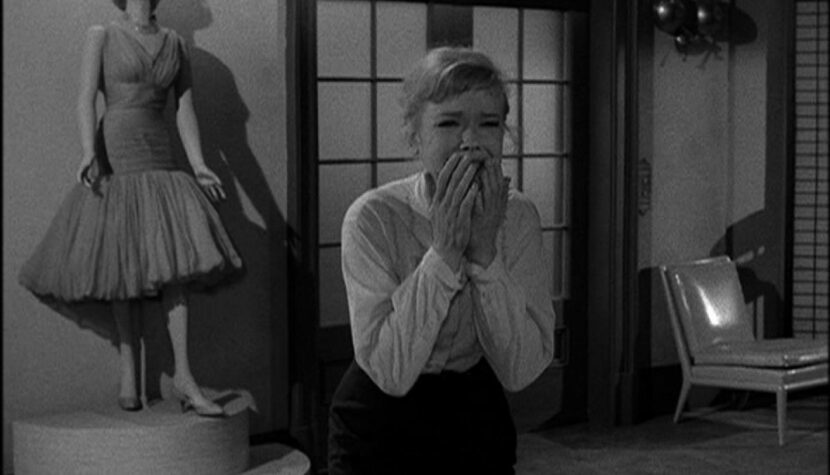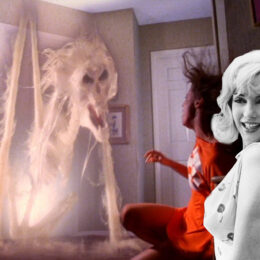THE TWILIGHT ZONE. “After Hours”, or what it would be like to be human

A masterpiece of television, a pop culture phenomenon – The Twilight Zone. The cultural significance of this series cannot be overestimated. It was here that brilliant plot ideas and narrative solutions first appeared, which later inspired famous horror and science fiction filmmakers. Without The Twilight Zone, films such as The Truman Show or Ex Machina would not have been made, but also series such as Black Mirror or The X-Files.
The Twilight Zone is probably one of the most perfect creations of American television, which is why it is so hard for me to understand how this series has not been shown in its entirety by any Polish television or streaming platform (in the 80s and 90s, two different TV channels broadcast some episodes from two different seasons). Especially since only a few years ago, the master of American horror, Jordan Peele, created two seasons of his version of The Twilight Zone.

The creator of the original was Rod Serling, who with his idea for the series perfectly shot into the historical moment when television was still a new invention. It is a time of experimentation and a lot of creative freedom. So Serling had the opportunity to create an ambitious TV series over which he managed to maintain creative control. The series had five seasons and was broadcast from 1959 to 1964 (in 1985 the series was resumed, and such creators as Wes Craven, William Friedkin and George R. R. Martin worked on the episodes). Serling hired writers he trusted, although 92 of the 156 episodes were written by himself. The series is in the form of an anthology, and each episode is an independent, closed story. Not only does Serling hold the reins behind the scenes of The Twilight Zone, he also appears as the narrator in every episode. It is he who announces the theme of the episode in short, several-second introductions – he introduces the characters, outlines the problem they face, and sums up their fate at the end.

The series’ permanent opening credits with distinctive music are intended to evoke a sense of unease and surrealism in viewers. Episodes balance on the borderline of thriller, science fiction and horror, each time weaving human tragedy and moral dilemmas into it. The heroes of The Twilight Zone always face a difficult, inexplicable phenomenon, often find themselves in a dead end situation. Episodes often deal with socially important issues, such as the problem of race and gender, totalitarianism or the threats of new technologies. The series does not fall into ridiculousness or absurdity, and the plots invented by the creators are completely believable. This is due to the perfectly constructed, though very short, maximum 25-minute episodes. A constant element of each episode is the gradually built tension, the feeling of uneasiness and the feeling of eerieness accompanying the viewer, crowned with a plot twist that will make you feel dizzy.
Basically, each episode of Serling’s The Twilight Zone would deserve a separate discussion. Many of them were described by my editorial colleague Kasia Kebernik in her brilliant, cross-sectional text about the phenomenon of the series. The history of The Twilight Zone is full of absolutely brilliant episodes. My favorite, however, is definitely the lesser-known episode from the first season called The After Hours.
This is no ordinary department store
The protagonist is Marsha White (Anne Francis), a young woman who visits a department store in search of a present for her mother. “Miss Marsha White is on the ninth floor, in the miscellaneous department, looking for a golden thimble. Chances are he’ll find it, but there’s an even better chance he’ll find something else, because this is no ordinary department store. It’s the twilight zone,” Serling says in the episode’s preview. Marsha asks the staff on which floor she can find what she is looking for, and the elevator operator takes her to the ninth floor. The girl is surprised because the floor is empty. Suddenly, however, a saleswoman approaches her and pulls out from under the empty counter exactly the gold thimble Marsha is looking for. The girl is confused and the whole situation makes her uneasy. She nervously pays the clerk, who calls her by name, and flees to the elevator. There, however, she notices that the thimble has scratches and dents, so the elevator operator directs her to the third floor to the claims department.

Marsha tries unsuccessfully to explain to the store managers where she bought the thimble, as the men claim that the department store does not have a ninth floor. Marsha does not have any confirmation of the transaction – she paid in cash and did not receive a receipt. Suddenly, she spots a mannequin in the window that looks exactly like the woman who sold her the thimble. Shocked, Marsha wants to rest for a while in the office, but she completely loses track of time.
Finally, he realizes that there is no one else in the store. She thinks she hears voices and the mannequins in the store are moving. One of them looks exactly like the elevator operator. Marsha starts to panic and runs into the open elevator, which goes by itself to the ninth floor. There, she begins to realize that she knows this place – it’s a storeroom filled with … living mannequins. They begin to approach her, smile friendly, extend their hands to her. Marsha begins to understand that she herself is a mannequin. Reconciled to her fate, the next day she is already on the shop window.

Cultural and film tropes
This brilliant episode of The Twilight Zone resounds in an interesting way with cultural and film tropes that have been occupying creators for centuries. The heroine in The After Hours does not want to be who she is. The message of this episode is even clearer in the remake from the 1980s. Terry Farrell plays Marsha, who completely cannot accept that she is a dummy and not a human. The desire to become a person at all costs is a cultural trope known, for example, from Carlo Collodi’s Pinocchio or Mary Shelley’s Frankenstein and explored in various ways by filmmakers. In Return to Oz (1985), King Nome’s desire to be human turns him into a bitter villain. A.I. Artificial Intelligence (2001) by Spielberg is the story of David (Haley Joel Osment), a small robot who dreams of being a boy who loves and is loved. In science fiction films, the line between artificial intelligence and humans is often blurred, which in itself is an interesting moral problem (Ex Machina).

Character change is the domain of classic fairy tales and myths. Being human is a desired state, and turning into an object or an animal can be a form of severe punishment or magic, as in the classic fairy tale about Cinderella, The Frog King (and one of its several film versions, i.e. Disney’s The Princess and the Frog) or in Beauty and The Beast (adapted for the screen many times), where the servants at the castle are turned into household items – cups, jugs, brooms, wardrobes and candlesticks. In Shrek, the enchanted Fiona turns into an ogress every night, and when she meets her true love, she decides to become one forever.
This brilliant episode of The Twilight Zone also addresses the age-old cultural trope of the belief that objects around us are alive. This idea became the basis for the Toy Story series, but it is a very common thread, especially in horror movies – from living, murderous cars (Christine), through houses (Amityville, The Conjuring and many others), clothes (In Fabric, Slaxx) or dolls (Child’s Play, Annabelle), and mannequins (Maniac, Tourist Trap).

However, mannequins as stationary objects are especially terrifying because, like dolls or robots, they resemble real people. The humanoid, the most human-like, is the scariest for us. Scientists have even conducted research on the subject, coining the term uncanny valley. According to this theory, a character (whether a robot or a movie character) who looks and behaves like a human being, but not 100% and not in the way we expect, always evokes anxiety and unpleasant feelings in the recipient. Filmmakers use this psychological effect very often, creating humanoid monsters to evoke horror or disgust in us (Splice, Alien, Gollum in The Lord of the Rings, Samara in The Ring and many others).
In yet another way, filmmakers use stationary objects, such as mannequins, sculptures, and various types of human-sized dolls, to evoke horror in us. A thicket of mannequins in a shop window or sculptures in the city space is an opportunity for a perfect hiding place for the hero – all he has to do is position himself in a similar pose to escape those who are chasing him (Buster Keaton’s Scarecrow, Blade Runner). Sometimes, however, this is how the villain lurks for his victim (Jurassic Park III, the giallo film Seven Black Notes).
After Hours is therefore a multidimensional episode that can be analyzed from the perspective of various cultural clues. Above all, however, it is an excellent piece of American television, one of its finest achievements – perfectly written and full of suspense.


